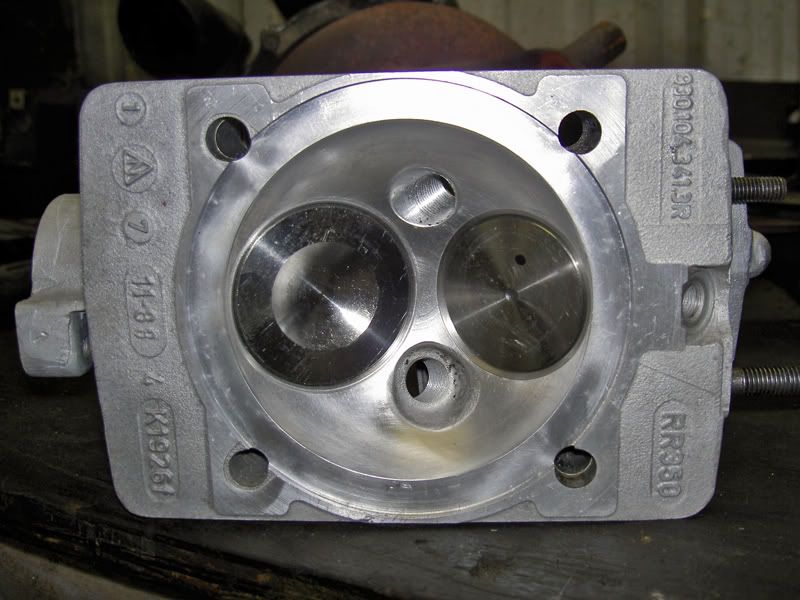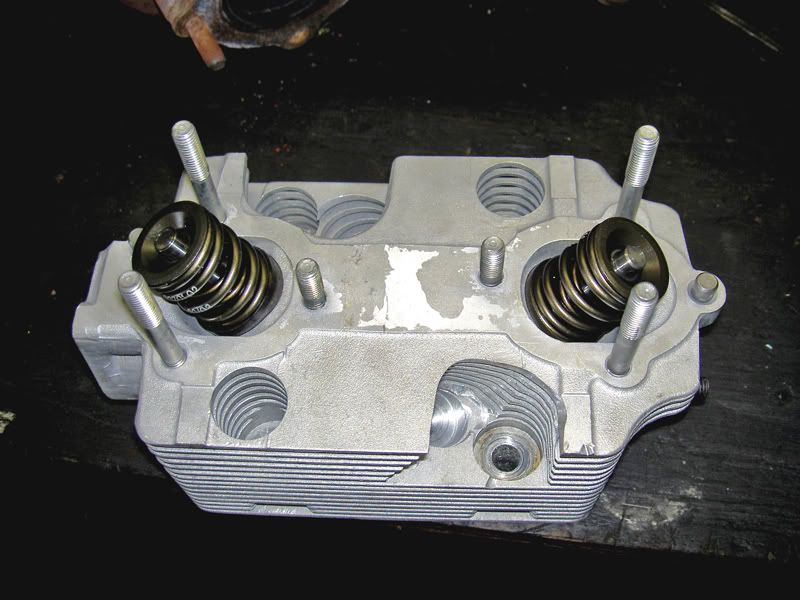Compression ratio question
#1
The twin plug heads I'm using for my conversion were shaved 1mm resulting in a compression ratio (with the stock P&C's) of 7.8 to 1. The 3.4 Mahle's that I put in have a ratio of 7.5 to 1 with all things being equal.
Is there a way to calculate my current compression ratio's with these two figures?
Is there a way to calculate my current compression ratio's with these two figures?
#2
My understanding is the compression ratio is a measure of compressed the air is between the heads and the pistons. In simplest terms it's goverened by how close the piston comes to the top of the inside of the head. A set of pistons and cylinders has a set compression ratio based on an anticipated stock head height. If my assumptions are correct then, having shaved the heads to an anticipated 7.8:1 ratio, that now is your new compression as it has lowered the height from stock.
David
1986 911 Turbo
David
1986 911 Turbo
#3
I would question that your heads were shaved 1mm. The spec is a maximum of .020" (.5mm) and at that point the bottom fin is extremely thin. When they are shaved that much, the sealing surface becomes very weak unless the bottom two fins are welded.
The stock pistons have a true compression ratio with unshaved heads of around 6.5-6.8:1 compression with the stock heads giving a volume of about 94cc. The Mahle 3.4 7.5:1 pistons (both traditional and Ruf short skirt) have a net dome volume of about 7cc. When you use the proper bore 97 or 98mm depending on which P&C you are using and a stroke of 74.4 or 76.4mm depending on which crank you are using you can figure out the compression ratio and adjust it slightly with the deck height clearance.
The stock pistons have a true compression ratio with unshaved heads of around 6.5-6.8:1 compression with the stock heads giving a volume of about 94cc. The Mahle 3.4 7.5:1 pistons (both traditional and Ruf short skirt) have a net dome volume of about 7cc. When you use the proper bore 97 or 98mm depending on which P&C you are using and a stroke of 74.4 or 76.4mm depending on which crank you are using you can figure out the compression ratio and adjust it slightly with the deck height clearance.
#4
Thanks Geoffrey,
They were indeed cut 1mm (.040") as we had to machine the chain housing 1mm to compensate. We did'nt weld the fins, so I hope they hold together.
Jim
They were indeed cut 1mm (.040") as we had to machine the chain housing 1mm to compensate. We did'nt weld the fins, so I hope they hold together.
Jim
#5
Why would anyone cut the head .040" That is TWICE the wear specification from Porsche on a cylinder head application that already has known leaking issues. Can you post a picture, I'd like to see that.
I would also cc your cylinder head because that is a lot to cut off and will affect the compression ratio significantly. You will want to make sure you have done the measuring process and know exactly what the compression ratio is otherwise you may end up where Don Enderline is now.
I would also cc your cylinder head because that is a lot to cut off and will affect the compression ratio significantly. You will want to make sure you have done the measuring process and know exactly what the compression ratio is otherwise you may end up where Don Enderline is now.
Trending Topics
#10
Originally Posted by Geoffrey
I measure the compression ratio of EVERY engine I put together, just as I degree EVERY cam I install rather than using the lift at TDC method. But hey, that is just me...
#11
cc the head, the piston and using the bore and stroke, taking into consideration your deck height clearance and head gasket (if any) figure it out.
I use to do it long hand but my engine modeling program does it for me.
compression ratio = (volume of the cylinder + volume of the head) / volume of the head
Since the piston you are using has a slight dome to it, you need to take that into consideration for the volume of the cylinder. I have measured the dome to be 7cc, but you'll want to verify that on your specific pistons as I've seen Mahle pistons inconsistent. If you want to be very exact, you can take into consideration the volume between the piston and cylinder between the top compression ring and the top of the piston.
I use to do it long hand but my engine modeling program does it for me.
compression ratio = (volume of the cylinder + volume of the head) / volume of the head
Since the piston you are using has a slight dome to it, you need to take that into consideration for the volume of the cylinder. I have measured the dome to be 7cc, but you'll want to verify that on your specific pistons as I've seen Mahle pistons inconsistent. If you want to be very exact, you can take into consideration the volume between the piston and cylinder between the top compression ring and the top of the piston.
#13
Originally Posted by jimculp
The twin plug heads I'm using for my conversion were shaved 1mm resulting in a compression ratio (with the stock P&C's) of 7.8 to 1. The 3.4 Mahle's that I put in have a ratio of 7.5 to 1 with all things being equal.
Is there a way to calculate my current compression ratio's with these two figures?
Is there a way to calculate my current compression ratio's with these two figures?
2. The 3.4 litre engine displaces 561.27cc per cylinder with its 98mm x 74.4mm bore/stroke, this is the Swept Volume
3. What you have to calculate is the compressed volume of the 3.4 kit with a stock 90cc cylinder head:
CR = (SV+CV)/CV or = (SV/CV) +1 where SV = Swept Volume and CV = Compressed Volume.
Transposing this equation gives CV = SV/(CR-1) which in this case is 561.27/(7.5-1) = 86.35cc Compressed Volume
4. Now we can calculate the new CR with a new compressed volume of 86.35cc - 7.0cc skim = 79.35cc
5. CR skimmed = (561.27/79.35) + 1 = 8.07:1
OK?
The following users liked this post:
torseilertsen (11-24-2022)
#14
Originally Posted by Geoffrey
Why would anyone cut the head .040" ?
We must have got something right because the engine put down 325hp at the tyres on a dynojet with mild cams, throttle bodies, Motec and headers. This was the engine that pushed me into designing my own cylinder heads, because the work involved in machining the pistons and heads, coupled with the aggravation of fitting the 964 heads onto a 993 engine/exhaust meant that it was not a feasible proposition for customer engines.
With respect to the 3.4 turbo build, all I recommend is that you set the piston to head squish to no more than 1.0mm around the edge of the combustion chamber, if necessary shorten the cylinders to achieve this as the benefit in supressing detonation and improving combustion are huge.
#15
Originally Posted by NineMeister
1. The diameter of the combustion chamber at the head face is approximately 95mm, so by skimming 1.0mm (0.040") from the face you have reduced the compression volume by approximately 7cc (9.5 x 9.5/4 x PI x 0.1).
2. The 3.4 litre engine displaces 561.27cc per cylinder with its 98mm x 74.4mm bore/stroke, this is the Swept Volume
3. What you have to calculate is the compressed volume of the 3.4 kit with a stock 90cc cylinder head:
CR = (SV+CV)/CV or = (SV/CV) +1 where SV = Swept Volume and CV = Compressed Volume.
Transposing this equation gives CV = SV/(CR-1) which in this case is 561.27/(7.5-1) = 86.35cc Compressed Volume
4. Now we can calculate the new CR with a new compressed volume of 86.35cc - 7.0cc skim = 79.35cc
5. CR skimmed = (561.27/79.35) + 1 = 8.07:1
OK?
2. The 3.4 litre engine displaces 561.27cc per cylinder with its 98mm x 74.4mm bore/stroke, this is the Swept Volume
3. What you have to calculate is the compressed volume of the 3.4 kit with a stock 90cc cylinder head:
CR = (SV+CV)/CV or = (SV/CV) +1 where SV = Swept Volume and CV = Compressed Volume.
Transposing this equation gives CV = SV/(CR-1) which in this case is 561.27/(7.5-1) = 86.35cc Compressed Volume
4. Now we can calculate the new CR with a new compressed volume of 86.35cc - 7.0cc skim = 79.35cc
5. CR skimmed = (561.27/79.35) + 1 = 8.07:1
OK?




